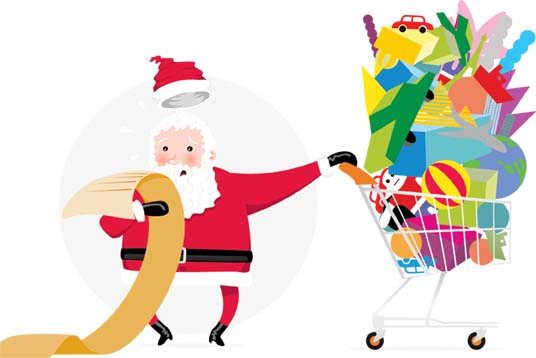Santa Claus came this year after all. According to MasterCard Advisors’ SpendingPulse, total holiday retail sales for the period between November 5 and December 24, 2010, increased 5.5 percent over 2009 to $584 billion. 2009 sales increased only 1.1 percent over 2008, to $446.8 billion, according to the National Retail Federation (NRF). “It has been a very good holiday season,” said Scott Krugman, a spokesman for the NRF. “Retailers found a good way to tap into spending power, despite the lack of consumer confidence.”
Michael Niemira, vice president of the International Council of Shopping Centers (ICSC), summed up Christmas 2010 as the best season in terms of growth since 2006. “When all the totals are calculated, it should be the strongest level of holiday sales on record.”
 This season, shoppers paid for their gifts with cold, hard cash. Britt Beemer, chairman of America’s Research Group (ARG), said that on November 1, when his firm asked shoppers how they would pay for their gifts, 16 percent said they would use credit cards, a decrease from 32 percent in 2009. When ARG surveyed shoppers over Christmas weekend, 15.2 percent said they used credit to
This season, shoppers paid for their gifts with cold, hard cash. Britt Beemer, chairman of America’s Research Group (ARG), said that on November 1, when his firm asked shoppers how they would pay for their gifts, 16 percent said they would use credit cards, a decrease from 32 percent in 2009. When ARG surveyed shoppers over Christmas weekend, 15.2 percent said they used credit to
buy presents, a decline from 28 percent the previous year. “They were really committed to not getting back into a situation where they are getting calls from credit card companies,” Beemer observed.
According to SpendingPulse, whose data is supplied by MasterCard Advisors using estimates for total U.S. retail sales, 2010 jewelry sales for the month of December saw a 10.4 percent increase compared to the previous year. For the same period in 2009, jewelry sales increased 6.9 percent from 2008.
“The jewelry sector outperformed all because the luxury customer is not concerned about price,” Krugman said. Michael McNamara, vice president of research and analysis at SpendingPulse, agreed. “As with the luxury sector, jewelry sales tend to correlate with the performance of the financial markets. There was probably some pent-up demand out there, after two relatively lean holiday seasons.”
But, Niemira warned, “This kind of acceleration that we have gotten in the luxury sector is likely to settle down in 2011.”
Online retail sales in 2010 rose 12 percent to $32.6 billion from November 1 through December 31, according to metrics firm comScore. For the same period in 2009, online retail sales totaled $29 billion. Jewelry and watch sales did well, with 2010 sales rising 11 percent from the previous year. McNamara noted that jewelry sales spike right before Christmas. “The week before the holiday usually accounts for over 40 percent of December jewelry sales. The ten days before Christmas are the top ten jewelry sales days of the month and make up over 50 percent of December sales,” he stated.
But when shoppers ventured out to find deals, they did not hit the mall. “We asked consumers where they shopped each weekend. A lot went to freestanding stores — you are going to see that people went to the malls a little less,” Beemer said. He noted that when consumers were asked where they shopped, 40 percent said WalMart, compared to 55 percent a year ago, but double the number of shoppers went to JCPenney this year compared to last. Beemer believes this is because 40 percent of parents said they would wait until Christmas to do back-to-school shopping. “Children’s apparel purchases increased 23 percent to 25 percent each weekend. JCPenney has a huge children’s clothing area and they offered great deals.”
Ryan Sweet, senior economist at Moody’s Analytics, expects the spending trend to continue. “During the recession, consumers were trading down,” he pointed out. “They were trying to get the biggest bang for the buck. But now they feel comfortable trading up and are tiptoeing back into department stores.”
Computer hardware was the fastest growing online retail category, according to comScore, with a 23 percent increase. Books and magazines was up 22 percent, while consumer electronics rose 21 percent, computer software — excluding PC games — jumped 20 percent, toys increased 16 percent and apparel and accessories grew 8 percent.
In a survey conducted by the ICSC, consumers reported that 14.5 percent of their holiday gift purchases were in the form of a gift card or certificate, making it the highest percentage since 2007. In 2009, the rate was only 13.1 percent. However, due to a December blizzard that crippled much of the East Coast and the
Midwest during the week between Christmas and New Year’s — a prime time for shopping — 2010 holiday gift-card redemption rates fell. An average of 10.8 percent of gift cards were redeemed between December 26 and December 31, compared to 20.9 percent in 2009.
Niemira had mixed feelings about the upcoming year. “Pricing will become an issue, especially when it comes to gasoline and food, and some expect inflation. But the big positive for 2011 will be payroll tax reduction — $112 billion back in the hands of consumers. That will be a nice lift,” he said.
Sweet expects spending to slow in early 2011. “It will be a bit of a holiday hangover,” he said, adding that the labor market is crucial to recovery. “We need to see business begin to hire, which will generate labor income to support additional sales. Going forward, it’s likely that consumers will spend more aggressively,” he concluded.
Article from the Rapaport Magazine - January 2011. To subscribe click here.